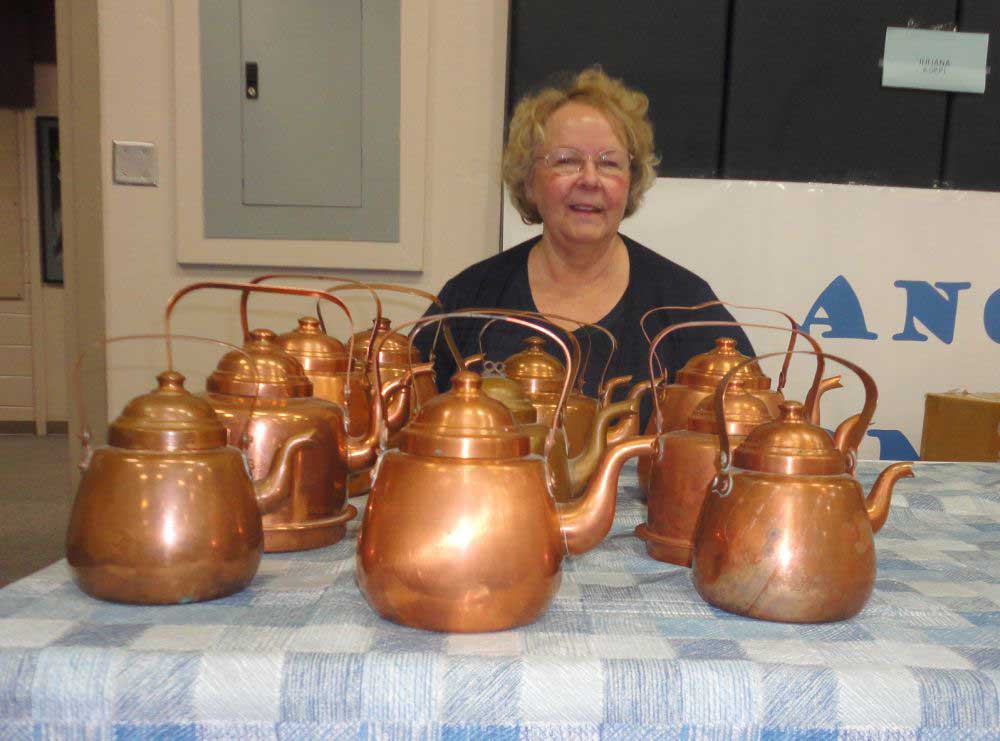Heritage & pride at the Finnish-American Folk Festival
Published 5:00 pm Sunday, July 27, 2014

- <p>Juliana Armstrong displays her collection of antique copper teakettles from Finland during the Finnish-American Folk Festival over the weekend in Naselle, Wash.</p>
NASELLE, Wash. Her collection of copper teakettles was not worth giving up her marriage.
A retired school principal from Anchorage, Alaska, and full Finn, Juliana Armstrong has spent the last 20 years collecting antique copper teakettles from Finland. She identifies authentic Finnish kettles by their small engravings located on the handles and from years of collecting antiques.
Julianas collection has quickly boiled over to more than 100.
Her collection of teakettles lines the tops of 17 tall bookshelves three or four to a shelf and after downsizing from a three-story to a one-story home, husband Glenn Armstrong kindly asked that she part way with a few of her teakettles or 40.
The couple planned their entire summer around Naselles three-day Finnish festival.
While driving down the Oregon Coast last summer, they noticed a sign for the 2014 Heritage Days, Naselles biennial Finnish-American Folk Festival. It seemed like the perfect spot for Juliana to find new homes for her copper teakettle keepsakes.
Fast-forward a summer, several rolls of bubble wrap, Styrofoam and three days of driving later, the Armstrongs found themselves back in Naselle at the festivals Tori, which is Finnish for marketplace, pruning their collection and proudly sharing pieces of Julianas heritage.
Crowds of folks with Finn in their blood weaved in-and-out of classrooms at the Naselle-Grays River School poring over family trees as large as whiteboards, listening to stories about Finnish ancestors, watching documentaries on the Sami, or Finno-Ugric people, learning pieces of the Finnish language, reuniting with old classmates, friends and extended family members celebrating their heritage. In the schools courtyard, bellies were full of Scandinavian treats like Swedish pancakes and sausages on sticks. Musical performances in the commons filled the hallways with Finnish tunes and other melodies from groups including As A Sparrow, Folk Voice, Dolores Villa Real, Aallotar, the Finnish American Choir and the Smilins Scandinavians polka band. Some festivalgoers were dressed in traditional Finnish attire known as kansallispuvut, which usually includes a dress, apron and lacy cap for women and trousers with knee-high knickerbockers and a vest for men.
Filling a hole with teakettles
Juliana Armstrong is 100 percent Finnish: Her husband has not an ounce of Finn in him, but is a supportive spouse of his wifes hobby. Her maiden name is Korpi, which is Finnish for wilderness.
Growing up, Julianas Finnish grandmother had a copper teakettle much like the ones Juliana collects from antique stores and online websites like eBay.
My daughter says the reason I started collecting (teakettles) is because my aunt had one and gave it away, Armstrong said. I felt such a loss that she had not asked me before giving it away that I wanted to replace it. There was a hole left and Ive filled it with a million others just like it.
She admits shes gone a little overboard on collecting the lovely metal pots, but made it clear to her husband she wouldnt give any up unless she was sure they were going to a good home.
People dont really feel strongly about the collectible teakettles unless they remember their grandmother having one, she said. The people who are buying my teakettles are people who remember their ancestors having them around.
Why copper teakettles?
According to Armstrong, Finland has a lot of copper mines, which explains the abundance of copper teakettles that still exist today. There are seven recorded copper mines in Finland, including mines in Ahmavaara, Kivimaa, Konttijärvi and Mullikkoräme.
Because Finns no longer use teakettles to prepare their tea due to advances in technology, Armstrong considers the kettles to be a collectors item.
They are something that is not really used anymore, she said. Similar to vintage Coke bottles, they evoke a memory or feeling.
Friendship, family, closeness and warmness in the kitchen are just a few feelings that come to mind for Armstrong.
She collects three main types of teakettles stovetop, those with wooden handles and teardrop-shaped kettles that used to fit into the top of wood stoves.
Some of her copper kettles have dents and small dings, which she says add character. Some dont have lids and can be filled with silk flowers for decoration. Something can be done with even the littlest one, she said.
They are a reason for me to connect with my heritage, which I am so proud of, she said.
The funds she raised from selling her collection of copper teakettles and Kalevala plates will go toward the Anchorage Suomi-Finland Club, which promotes Finnish pride and fraternization.
Finnish friendship
The Tori was a sea of vendors in blue and white selling Finnish trinkets. Artwork, costume jewelry, clothing, knives and other heirloom-type objects were changing hands.
Dorothy Penttila of Montesano, Wash., had four first-place ribbons hanging in her booth from Grays Harbor County Fair for her Finnish handiwork. She has been involved in all 17 of the Heritage Days over the last 34 years.
She sold handmade placemats, rugs and runners woven from old bedsheets, African salvage scraps, drapes, cotton stocking loopers and other scraps and donated materials.
Homes in Finland are all hardwood, Penttila said. None of them have carpets really, so I make rugs that people put down to use when they are getting out of their saunas.
Saunas are a Nordic tradition, and almost every home in Finland features a sauna either built into it or as a separate building on the property.
According to Megan Rainey of Astoria, who was working the FinnWare booth, saunas, which are essentially large steam baths, are a social experience.
In Finland, saunas are a time for people to bond, she said.
I make the sauna rugs because I want to keep Finnish traditions alive, Pentilla said.





